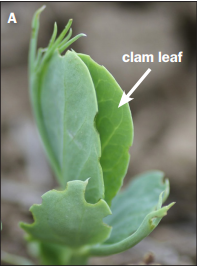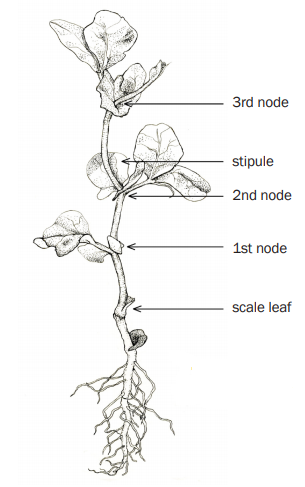
Pea Leaf Weevil
Pea leaf weevil is an introduced pest that has become established in Montana and continues to move eastward in areas planted with field peas.
Last Updated: 11/16by Kevin Wanner, Associate Professor, Plant Sciences and Plant Pathology
Species name:
Sitona lineata L.
Appearance:
The adult pea leaf weevils (PLW) are slender greyish-brown beetles about 1/5" long with a broad-shaped snout (Figure 2A). The legless larvae are soft bodied and milky white in color with a darker head, about 1/7 to 1/5" in length. Larvae curl into a “C” shape when exposed (Figure 1D).
Host range:
PLW infests wild and cultivated legumes, but typically causes economic damage only to field peas and fava beans. Chickpeas are not preferred, but may become infested wen a nearby host crop has been removed and resident weevils migrate into the chickpea crop to mate and lay eggs. Lentils are not considered a host for PWL. Secondary host crops for adult feeding include clover and alfalfa, but the larvae do not develop on these crops.
Geographic range:
PLW is native to Europe, Asia and Africa and was introduced to the west and east coasts of North America in the 1920s. It has become established as an economic pest in Washington, Idaho and western Montana as well as Alberta and western Saskatchewan. North American populations are moving eastward as the acreage planted to field peas has expanded in the last decade. As of 2015 PWL had migrated eastward to Lewistown but had not yet reached the major pulse acreage grown in the northeastern corner of Montana. However, in August of 2016 PLW was detected in Golden Valley County, ND. Producers in the MonDak region are encouraged to report signs of adult feeding damage (Figure 1A) to their local county extension office.
Damage:
The adult weevils feed on the leaves, chewing a halfmoon-shaped notch in the leaf edge (Figures 1A/B). Defoliation typically does not cause economic damage since the crop usually compensates and recovers. However, when weevil populations are high and the plants have only recently emerged, adult feeding can cause significant damage. Yield loss is believed to occur as a result of larval feeding on the nitrogen-fixing root nodules (Figure 1C), which may reduce the amount of nitrogen being contributed to the soil. High PLW populations may destroy up to 90% of the root nodules. While adult weevils can feed on a wide variety of legume plants, the larvae only survive to adulthood on the root nodules of field pea and fava bean crops.
Not to be confused with:
Pea weevil (Bruchus pisorum) is a different pest of peas that has a similar common name. Pea weevil lays its eggs on the developing pea pod and the larvae consume the peas inside, and the adults are very different in appearance (Figure 2C). Sweetclover weevils (Sitona cylindricollis) can be a pest of clover and the adults are very difficult to distinguish from PLW, and both can be found in alfalfa crops. If the specimens are fresh and undamaged, parallel lines along the abdomen of the PLW (Figure 2A) can distinguish it from the sweetclover weevil (Figure 2B).
Life cycle:
Adults primarily overwinter in surrounding roadsides, shelterbelts and perennial legume crops such as alfalfa. Early in the spring on warm days the adult weevils begin to fly into field pea or fava bean crops to feed and mate (in Europe flight does not occur below 55°F). Feeding damage to the leaves is often first noted on the field edges. Migration into the crop may last for several months and is influenced by spring temperatures. After a period of feeding, female weevils mate and scatter eggs over the soil surface (Figure 2A). Females lay as many as 1,655 eggs over their life span, primarily when temperatures are between 54 and 72°F. After 2-3 weeks the eggs hatch, and newly emerged larvae burrow into the soil searching for root nodules on the host plant. The larvae feed within the root nodules for 4-8 weeks before developing to the next generation of adults. Sometime around late July or August adult weevils emerge from the soil and feed on a variety of legume hosts, but do not cause economic damage at this stage.From late summer to fall the adults fly and migrate to their overwintering sites.




A B C D
FIGURE 1. A/B) Adult pea leaf weevils make distinctive half-circle notches in the edges of pea leaves; C) Immature larvae feed within nitrogen fixing root nodules; and D) Mature larvae are white, with c-shaped bodies and brown heads.

A


B C
FIGURE 2. Several weevil species in legumes look similar: A) Female pea leaf weevil with freshly laid eggs (arrows) on the soil; B) sweetclover weevil; C) pea weevil.

FIGURE 3. Staging the growth of field peas. Illustration by Tember Dykgreve
Management:
Preventive insecticidal seed treatments protect the root nodules from larval feeding and the foliage from adult feeding. However, the decision to treat seed should be based on the history of weevil damage in previous years, since planting occurs before pest activity can be monitored. Foliar sprays can be applied before the 6th node growth stage (Figure 3). The economic threshold for spraying is reached when ¼ to ¹⁄3 of the plants have feeding notches on the clam leaf (the most recently emerging leaves that are still folded together). A row of 10-20 seedlings should be examined at several locations, including the interior of the field, to establish an average number of plants with feeding damage. Foliar sprays must control the female weevils before they lay eggs to prevent yield loss caused by the larvae. Some results suggest that seed treatments provide better control compared to foliar sprays, since sprays may not always control the adult females before egg laying occurs. Insecticides are listed on the High Plains IPM Guide
Additional resources
High Plains IPM Guide: http://wiki.bugwood.org/HPIPM:PC_ Pea_leaf_weevil
Pea Leaf Weevil Feeding Damage with Mating Adults, https://www.youtube.com/watch?v=yk8EV5_ppOI
Pea Leaf Weevil Overview by Alberta Entomologist Scott Meers, https://www.youtube.com/watch?v=YJ4BTe9xstA
IMAGE CREDITS - 1. A & C) MSU Crop Entomology; B & D) Michael Dolinski; 2. A) Michael Dolinski: B) RKD Peterson, C) Mariusz Sobieski, bugwood.org
Any mention of products in this publication does not constitute endorsement by Montana State University Extension. It is a violation of Federal laws to use herbicides in a manner inconsistent with their labeling.

